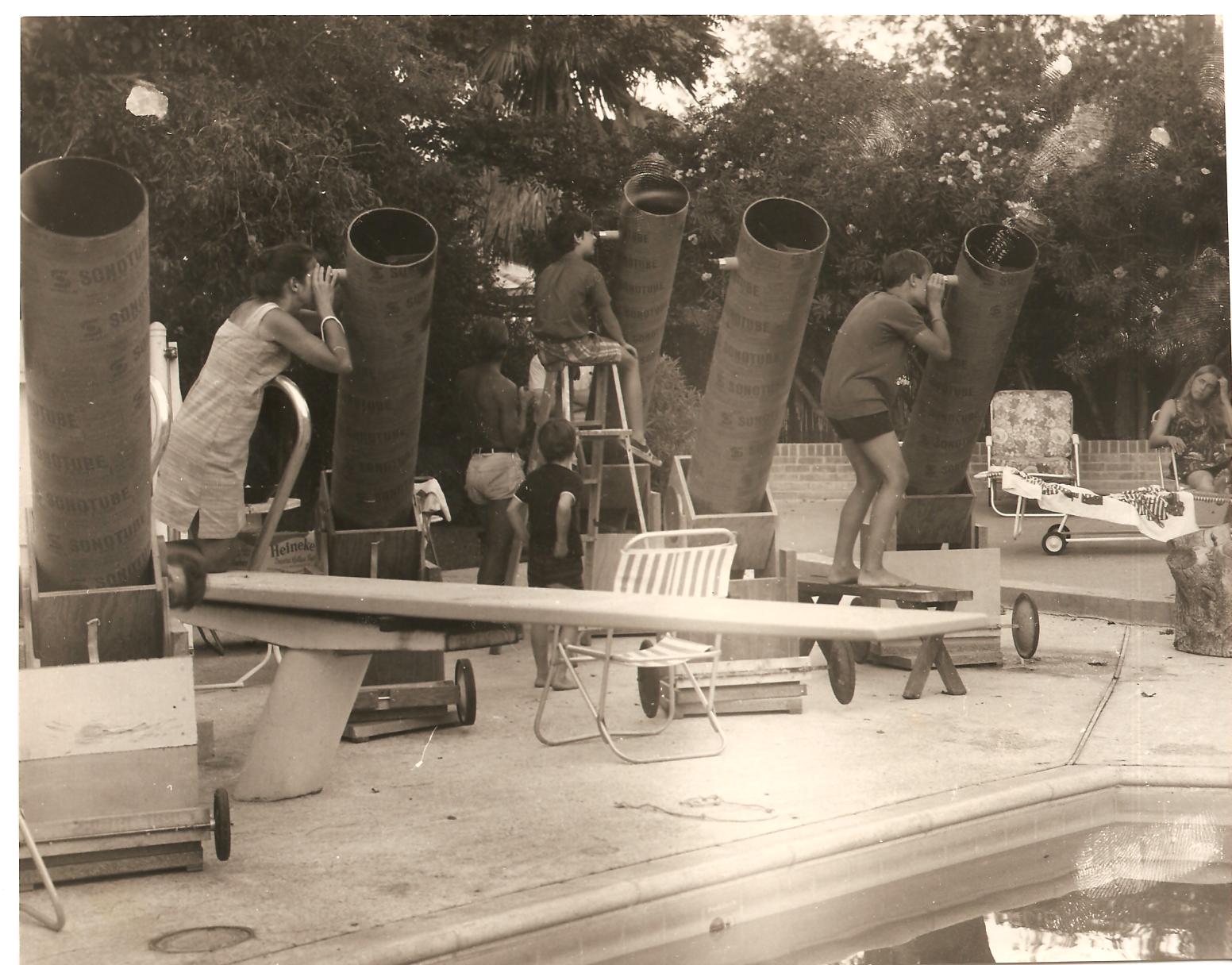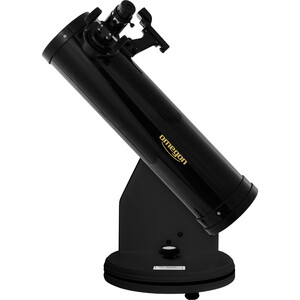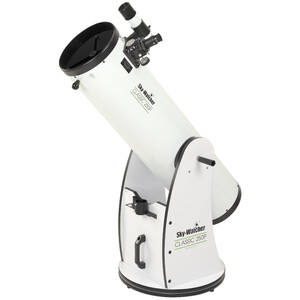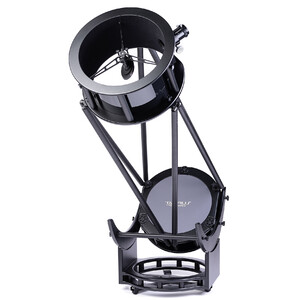John Dobson and his telescope for everyone
These days it is hard to imagine a world without Dobsonian telescopes. But who is the man behind them? The interesting story of their inventor John Dobson.
 John Dobson with a 24-inch telescope / photo: Sidewalk Astronomers
John Dobson with a 24-inch telescope / photo: Sidewalk AstronomersJohn Dobson's telescopes and philosophy have made an adventurous journey from a Hindu monastery in San Francisco, across the streets of America, to the gardens of amateur astronomers around the world.
His goal: to show us how the cosmos really is
With a diameter of 12,700km, the Earth is the centre of our universe. We work and live here every day. The hustle and bustle of our lives sometimes makes us forget that we are only a tiny blue dot in a universe full of stars, planets and galaxies, whose dimensions are beyond imagination.
In the 1960s, the chemist, monk, and amateur astronomer John Dobson (1915-2014) made it his mission to overcome this vastness. He wanted to make the night sky in all its wonder accessible to as many people as possible. "It's crazy to live in this universe without ever having seen it", he said. For 40 years, armed with nothing more than a home-made telescope and a burning passion for astronomy, Dobson showed children and adults what the universe outside our Earth's atmosphere really looks like.
The hobby astronomer, who observed asceticism, was never interested in fame or money. The Sidewalk Astronomers organisation and the ubiquitous Newtonian reflector with an azimuth mount - the so-called Dobsonian telescope - are proof of his legacy and revolutionary influence on amateur astronomy.
A monk reaches for the stars
John Dobson was born in Beijing in 1915 and moved to San Francisco at the age of 12 together with his family. There he graduated in chemistry in 1943 and quickly found work in the armaments industry at the height of the Second World War. However, when Dobson encountered the local Vedanta Society monastery, the avowed atheist discovered a completely new world. From then on, his scientific curiosity was accompanied by a spiritual quest.
Just one year later he became a member of the Ramakrishna Order and lived for the next 23 years as a monk at the Vedanta Monasteries in San Francisco and Sacramento. In this new environment, Dobson developed a strong interest in astronomy. As a professional chemist, he knew what the cosmos is made of (mainly hydrogen), but he now wanted to see the night sky with his own eyes, in order to understand it even better and find his place in it.
The road to the first Dobsonian telescope
In 1956, without money and without the knowledge of his superiors, he began to build his own telescope - literally from waste materials: plywood for the mount, cardboard cylinders for the tube, and the bottoms of old bottles or porthole windows for the mirrors. Of course, he also ground the latter himself.
 Dobsonian telescope / photo: Marcus Schenk
Dobsonian telescope / photo: Marcus SchenkTo this day, the simple design, low cost and intuitive use are the main features of the Dobsonian telescope, making it perfect for beginners. A large-diameter mirror that could collect a lot of light was built into the Newtonian reflector’s relatively short tube. The optics are seated in a so-called rocker box, which combines the functions of a tripod and mount in one, and which allows the telescope to be moved to the left and right, or up and down. Dobson said that anyone could build such a telescope themselves in just one week.
He later described how, through the eyepiece of his first 12-inch telescope, he saw the Moon surface as close as if he was about to land on it. Dobson was thrilled. The telescopes quickly became ever larger, and he was soon overcome with the desire to share his discoveries with friends and neighbours. Although the Vedanta community did not criticise the construction of the telescopes, in the end his many absences meant that in 1967 Dobson had to leave the monastery.
The Sidewalk Astronomers explain the night sky
The star-loving monk decided to dedicate himself exclusively to astronomy. Up until that point, there were few opportunities for amateurs to compete with the technology available to professionals. But with his assembly instructions for a Dobsonian telescope, suddenly anyone could start observing from their own back yard.
A large and powerful telescope became affordable and the hurdles for getting started with the hobby were removed. So it’s no surprise that it quickly became popular among amateur astronomers. Manufacturers, on the other hand, remained critical for a long time, since the 1980s the Dobsonian telescopes has been a firmly established product in the telescope market, and is available at Astroshop too.
 Sidewalk Astronomers event / photo: Sidewalk Astronomers
Sidewalk Astronomers event / photo: Sidewalk AstronomersIn 1968 Dobson, together with two like-minded people, founded the San Francisco Sidewalk Astronomers - an astronomy club that was worlds away from elite research communities and formal meetings. Dobson’s heartfelt wish was quite simple: to share his knowledge about telescopes and the cosmos with as many people as possible. http://www.sidewalkastronomers.us/index.html
At first he was to be found on a clear night with his telescope on wheels at the busy intersection of Broderick and Jackson Road, always ready to show passers-by the stars and planets with his own unique brand of humour. Later he and the Sidewalk Astronomers conquered the national parks of America with a decrepit old yellow school bus full of telescopes. It did not take long for a cult following to form around the charismatic astronomer with a white, bobbing ponytail. The not-for-profit organisation is active to this day, and still holds true to its original principles.
Observing and philosophising
John Dobson not only revolutionised amateur astronomy with his public engagement, but also spread his somewhat unorthodox view of cosmology. With his motto "Nothing does not exist", for example, he vehemently rejected the Big Bang theory. Influenced by the Vedanta philosophy, he instead believed in an immutable constant (Brahman) outside of space and time, similar to a divine origin.
 John Dobson / photo: Sidewalk Astronomers
John Dobson / photo: Sidewalk AstronomersObserving and philosophy have always gone hand in hand. When we look at the craters of the Moon, the rings of Saturn, or a distant galaxy, we cannot help but be fascinated by the origins of and reasons for the cosmos and our own existence as a tiny blue dot.
Dobson shared his curiosity, humility, and respect for nature in each of his workshops. In his words, besides hydrogen, the universe unfortunately still consists of far too much ignorance. He wanted to explain: "It is not important how large or how well the telescope is constructed, but how many people look through it." The Dobsonian telescope perfectly embodies this mission and philosophy through the story of its origin and its simplicity. It's the telescope for everyone - and maybe also exactly the right one for you. But you no longer have to build it yourself.
A selection of recommended instruments






